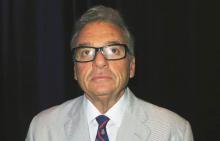Physicians appear to have much greater odds of substance abuse and dependence disorders related to alcohol, opiates, and sedatives than their nonphysician counterparts, some estimates showed.
The good news is that physicians with substance abuse and addiction respond particularly well to treatment – so much so that experts have recommended that the treatment methods employed in specialized programs for impaired health professionals be disseminated and used in programs for the general public.
“In a nutshell, for a physician with addiction who goes to an appropriate program that has expertise working with physicians and then follows up with 5-year monitoring, the average rate of abstinence of about 80% is the polar opposite of that in the general population, Dr. Daniel H. Angres of Northwestern University in Chicago said in an interview.
At best, the abstinence rate after treatment is about 20% for the general population, said Dr. Angres, an addiction psychiatrist and medical director of the Positive Sobriety Institute in Chicago, who has spent more than 3 decades working with physicians and other health care professionals struggling with drug abuse and dependence.
The key is proper treatment in a setting with other health professionals and long-term monitoring; without both, the outcomes won’t be as good, he stressed. But Dr. Angres added that there is more to it than that. Often, the very factors that drive a person to become a physician and help that person succeed in the endeavor are the factors that can improve the odds of beating addiction, he explained.
Scope of the problem
Substance abuse and dependence in general are on the rise. This is true among physicians as well as the general public. Opioid use has been a particular problem. A 2008 review by Dr. Mark S. Gold, former chair of the psychiatry department at the University of Florida, Gainesville, and Lisa J. Merlo, Ph.D., also of the university, noted that 12%-23% of physicians admit to prescription opioid use, compared with 1%-4% of nonphysicians (Harv Rev Psychiatry. 2008;16[3]:181-94).
However, Dr. Angres said there are few data to suggest that physicians are at substantially increased risk of addiction.
“The rule of thumb is that addiction affects probably 1 in 10 people. We can comfortably say about 10% will have an addiction problem at some point in their lives,” he said.
But addiction is a disease with genetic underpinnings, and while there was a time when it was thought that perhaps physicians had greater risk because they had greater access, the playing field with respect to access has been leveled over time. There are no good data to suggest that more than 15% of physicians are affected, Dr. Angres noted.
That’s not to say certain specialties aren’t overrepresented among addicts, he added.
Anesthesiologists, for example, have been shown to have a greater risk of addiction – perhaps as a result of their having access to, and/or excess exposure to, drugs like fentanyl and propofol. In fact, the review by Dr. Gold and Dr. Merlo also noted an increasing trend for abuse of sublingual and intravenously administered analgesics among health care professionals. Not far behind anesthesiologists are surgeons, pain doctors, and emergency physicians, Dr. Gold said in an interview. “We have proposed a number of theories to explain this, from self-selection bias to selecting anesthesia because of student drug use to second- and third-hand occupational exposure risks.”
Meanwhile, another 2008 study by Dr. Gold, Dr. Merlo, and their colleagues demonstrated that chronic secondhand exposure to low doses of drugs such as fentanyl and propofol among health care professionals in the operating room might sensitize vulnerable individuals to the “rewarding effects of these drugs, placing them at higher risk for developing an addiction.” The authors concluded that the findings, while they served only as “preliminary support for an unproven hypothesis,” suggest a need for workplace protections (J Addict Dis. 2008;27[3]:67-75).
Dr. Gold also led a more recent study comparing psychiatric and substance use disorders among physicians in a state Physician’s Health Program (PHP) with those in a general treatment population. He and his colleagues found that 99 physicians referred to the PHP for suspected impairment had similar lifetime use of alcohol, opiates, and sedatives as a group of age, sex, and education status–matched persons in a general treatment population.
However, the physicians had significantly higher odds of meeting DSM-IV criteria for abuse/dependence disorders related to alcohol (odds ratio, 2.56), opiates (OR, 86.58), and sedatives (OR, 54.76), the authors reported (J Addic Med. 2013 Mar-Apr;7[2]:108-12).


